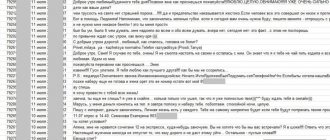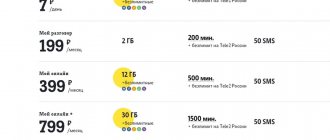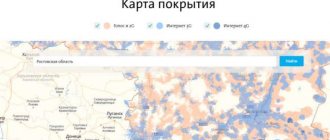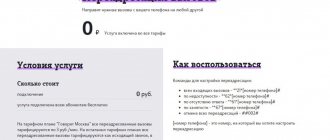To provide quality services to subscribers, MTS has created a modern telecommunications infrastructure, including its own mobile networks and services available to subscribers.
MTS coverage area
Currently, the operator offers a whole range of telecommunications services based on three main standards. A map of MTS coverage in the capital and regions is posted on this page, including the zones:
- 2G – cellular telephone communications;
- 3G – telephone communications and services, including conference calls, voice mail, access to multimedia and the Internet at a limited speed;
- 4G (LTE) – Internet, access to multimedia and various communication services, TV, video, video communication without speed limits.
Currently, MTS has deployed a serious technical infrastructure that allows it to receive various communication services while meeting the requirements for reliability, security, confidentiality and signal stability. Work continues on services that will be available to subscribers in the near future.
The proposed coverage map will help determine whether your geographic location falls within the MTS coverage area. At the same time, keep in mind that the Internet speed will be higher if you move no faster than 12 km per hour (namely, on foot or on a bicycle), slower if you are in a car. When moving between coverage areas of Moscow and other regions, seamless switching is carried out, invisible to the subscriber.
To use 4G (LTE), you need a special USIM SIM card and a device that supports LTE.
3G and 4G network coverage map of MTS operator
Currently, the coverage of high-quality high-speed 4G connections is provided in all major cities of Russia, and often extends to the region; this can be observed by taking the Moscow region as an example. To examine the coverage area in more detail, we need to look at the following separately:
- The coverage area is generally in Moscow and its environs.
- Coverage boundaries throughout Russia, using the example of large populated areas.
It is worth noting that this mobile operator is gradually expanding the boundaries of high-quality signal distribution, providing its subscribers with access to mobile Internet at high speed. In 2020, it is already planned to install additional towers to provide as many regions as possible with fast mobile Internet.
Important! The coverage sphere only reflects the approximate space where a particular signal operates, which is why in practice there may be an error at certain distances.
What other factors influence communication?
In some cases, the cell phone company is not responsible for poor signal strength. Several factors can affect transmission quality and coverage:
- Uneven terrain, for example, in mountainous and hilly regions with significant elevation changes, the signal may simply not reach the consumer.
- Worsening weather conditions, heavy snowfall and rainy weather, thunderstorms may affect reception.
- Significant load on the mobile network. If there are not enough base stations in a large city, then the quality of transmission may suffer significantly. This can be verified using the example of data transmission. You've probably noticed that during the daytime the speed of Internet access may decrease.
- A design defect of the mobile phone or non-compliance with standards. When purchasing a device, you should consider the frequency at which it receives. When purchasing a device abroad or from an unknown manufacturer, you should expect that it will not work on the Russian network.
- Outdated SIM card. Old SIM cards cannot work in 4G format. In this case, it can be changed at any branch of the provider.
- While in underground tunnels, in an elevator or in basements, the signal level may drop or disappear completely.
The article described a map of the MTS coverage area of the Russian Federation. When going on a trip, be sure to read it so you don’t end up without communications in your chosen region. The provider is gradually updating its equipment, which leads to a gradual transition to a more modern broadcast format.
Coverage map in Moscow
Currently, there is a good connection everywhere in the capital, only some isolated areas are still within 3G due to the presence of large forests or other difficulties in providing a high-speed signal. If you look at the map, you can see this in a small area in the Northeast, where the Elk Island National Park is located. Otherwise, a fast connection is available to subscribers everywhere, including areas remote from the center. All this allows users to fully surf the Internet from a mobile device.
MTS coverage map
To provide quality services to subscribers, MTS has created a modern telecommunications infrastructure, including its own mobile networks and services available to subscribers.
Currently, the operator offers a whole range of telecommunications services based on three main standards. A map of MTS coverage in the capital and regions is posted on this page, including the zones:
- 2G – cellular telephone communications;
- 3G – telephone communications and services, including conference calls, voice mail, access to multimedia and the Internet at a limited speed;
- 4G (LTE) – Internet, access to multimedia and various communication services, TV, video, video communication without speed limits.
Currently, MTS has deployed a serious technical infrastructure that allows it to receive various communication services while meeting the requirements for reliability, security, confidentiality and signal stability. Work continues on services that will be available to subscribers in the near future.
To use 4G (LTE), you need a special USIM SIM card and a device that supports LTE.
Coverage area in Russia
As for the situation in the country as a whole, it differs significantly from the capital. Here, only residents of large settlements have fast Internet, while those living in the surrounding areas are forced to be content with the 3G signal level. If you look at the map, you can highlight a lot of areas where the signal is actually weak. However, the company plans to gradually make changes, expanding the area of high-quality communication, providing residents of even remote areas with good reception.
Important! Do not forget that it is not always possible or meaningful to provide cellular gadgets with high-quality reception, since this can also be counteracted by the landscape features of the region.
Currently, MTS is one of the leaders in providing citizens with mobile communications. It is for this reason that the organization is actively developing and expanding the scope of its services, providing cellular data to residents of the entire country, and not just certain regions. Of course, all this takes time, but as MTS management assures, in the near future all residents of the state will be provided with a high-speed 4G connection.
What are coverage areas and how do they work?
Despite the rapid development of regional infrastructure, in some settlements there is a weak signal from the mobile network or is completely absent. The coverage area is a limited area perimeter where a subscriber can receive a stable level of communication. To provide services, the operator installs special base stations and towers throughout Russia. The more of them there are around the consumer, the more confident the reception will be. Moreover, the range of each individual antenna device is important. They can be divided into four categories:
- If a telephone tower operates at a frequency of 450 megahertz, then its range is about 20 kilometers.
- With increased performance up to 800 MHz, the radius is significantly reduced to 13 km.
- At base stations that use 1800 MHz, the range will be 7 km.
- The minimum is observed at a frequency of 2600 MHz - about 3 km.
This explains the fact that the 2G signal has a wider distribution throughout the country, even in the most remote corners. But MTS uses universal stations that allow you to work simultaneously on several frequency bands, which increases the quality of transmission and reception several times. In addition, the quality of cellular communications is affected by the number of consumers in a particular locality. The larger the city, the more radio towers are required.
MTS can support several generations of communications, including a more modern and high-speed network access standard - 4G. Currently, 2G and 3G are widely used; unfortunately, the latest LTE format has not managed to reach remote regions and populated areas. In some small cities, it is not profitable for a provider to provide communication services if the market there is already occupied by another company.
Internet access area
Many subscribers, when choosing a provider, pay special attention to the quality of the Internet provided. Each operator makes every effort to make the Internet faster and increase the amount of traffic included in tariff plans. Along with this, the MTS Internet coverage map is expanding, but its speed may vary in different places. It depends on how busy the network is and what the density of base stations is. With the launch of the LTE network, subscribers in large regions have the opportunity to use high-quality high-speed Internet. Thus, when traveling around Russia, MTS subscribers can count on high-quality communications.
MTS doubled LTE coverage in the Liskinsky district of the Voronezh region
Voronezh, RF — MTS PJSC (NYSE: MBT, MOEX: MTSS), the largest Russian telecommunications operator and digital service provider, sums up the results of the next stage of construction of LTE networks in the Voronezh region. Since the beginning of the year, MTS has more than doubled the number of base stations in one of the largest districts of the region - Liskinsky.
Residents of the villages of Nizhny and Sredny Ikorets, Vysokoye, Kovalevo, Kolybelka and others have the opportunity to use MTS mobile Internet at new speeds. In addition, 10 new base stations were launched in the regional center - the city of Liski. Now it has become more comfortable for MTS subscribers to access the World Wide Web, watch videos, communicate on social networks, use all available online services: government services, online shopping, mobile banking, buying train tickets, etc.
Residents of the area have already appreciated the benefits of fast and convenient access to the network. Mobile Internet traffic here has more than doubled since the beginning of the year. On average, in a month, subscribers in the Liskinsky district download so many gigabytes that would be enough to post 5 million photos on Instagram. There are several reasons for the popularity of the mobile Internet: the demand for online services is constantly growing, the penetration of modern smartphones, which are becoming more affordable, is increasing, and the development of MTS LTE networks provides high-speed Internet access for new gadgets.
How to use a card with coverage of cell towers in Russia?
Coverage map control buttons
At the top of the mobile networks map there are buttons for different cellular networks. If you click on them, the location areas of the selected cellular network will be shown. As you search for the best carrier in your area, it's helpful to gradually layer the coverage of different carriers on top of each other. At the same time, you can easily visually understand which operator’s signal will be the strongest in the area of your home.
Operator color on the coverage map
The coverage of the operators MTS, Yota, Beeline, Megafon, Tele2, SkyLink LTE, Rostelecom and others is displayed in different colors. At the bottom of the map there is a table describing the color of each operator. When you enable multiple operator coverages at once, they overlap each other. By turning on and off the buttons of different mobile operators, you will accurately and clearly determine the most powerful one in your location.
Fourth generation network coverage scheme
Before connecting to the services of a particular operator, you need to check that a particular locality has a reception area for the appropriate technology. If you look at the fourth generation network coverage map in more detail, you will notice that the proposed maximum speed on tariffs is 260 Mbit/s. This speed indicator will be enough to perform standard daily operations. The MTS 4G network coverage map will help users determine whether they are in the operator’s coverage area and whether it is worth using its services. Pay attention to one little-known fact: if the subscriber moves at a speed of up to 12 km/h, the Internet will work faster, and if the user moves in a car, the Internet will work slower.
On the MTS map you can also see plans for network development. The company is also ready to offer customers non-standard options that make it possible to organize local base stations capable of covering 20 meters. We are talking about compact terminals called “Confident Reception”. They operate via online channels at a speed of at least one megabit per second. MTS 4G network coverage is developing at a tremendous pace. In this regard, the company is ahead of other Russian cellular operators. MTS is committed to the future and its coverage map is expanding every year. You can familiarize yourself with the map in detail on the operator’s official page, where it is demonstrated in an interactive and detailed form.
How to do an Internet speed test from MTS?
You can check your Internet speed using a number of Internet resources. The provider does not offer its own web service, but subscribers can use a mobile application or provide data from third-party services. What do I need to do:
- this can be done from the site https://pr-cy.ru/speed_test_internet/ or the site https://www.speedtest.net/ru/
- when you log in, you will have information about the access point in the form of a table;
- run a speed test;
- write down the data and check it with the provision agreement; if you receive access in 4G format, the speed must be at least 112 Mbit/s (outgoing and incoming traffic has different speeds), check for more detailed information on the provider’s website or at an MTS store.
Network operation depending on region
Coverage by Russia's largest mobile operator has become commonplace almost everywhere. Subscribers were able to call from any corner of our large state. In addition, it has become much easier to make calls to other regions. We can say that the prevalence of operation of operator towers is conditionally divided by regions of the country. If a subscriber uses a tariff plan that allows him to use communications only within his home region, then when traveling to other regions of Russia he will be switched to another tariff plan, and the monthly fee will be completely different.
Coverage of the territory of the Russian Federation with mobile 3G/4G Internet
Compared to the successes of other countries, 4G coverage in Russia leaves much to be desired. For example, in Japan this figure reaches 75%, in European countries 56%. The world leader is South Korea, where high-speed access covers 80% of the country's area.
However, given that the area of the Russian Federation is huge, and part of the territory is sparsely populated, the indicator does not look so pessimistic. And if we take into account the fact that domestic communications remain one of the cheapest, then the situation moves from the unattractive category to the promising category.
The highest level of coverage is concentrated in Moscow and St. Petersburg, the coverage density of regional centers is growing every year, high-quality mobile Internet is gradually spreading across Siberia, the Far East and other remote regions.











